A Ruthenian parish was established here in the mid-1500s. The first wooden tserkva was situated in the hamlet of Wola; it was moved from that location in 1650 or after 1689, to the centre of the village. Construction of a new church of St. Demetrius was initiated in 1840 and probably completed in 1842. In the late 19th/early 20th century, magnificent illusionist figural and ornamental polychrome decorations were added inside the buildings. Situated in the vicinity of the tserkva, a free-standing wooden belfry, presumably from the 1700s, was reconstructed in 1927.
After the Ukrainian population was resettled from here in 1947, the building was abandoned and gradually falling into decay for years. In 1961 the preserved furnishings were taken to the Castle Museum in Łańcut. The belfry was demolished in the 1970s.
The three-part tserkva is oriented eastward. The narthex was once preceded with a vestibule supported on two pillars; its double pitched roof covered with sheet metal, which fell of the structure, has been preserved. The chancel on the southern and northern side is adjoined by the symmetrically located sacristy and treasury, both with rectangular floor plans. Over the nave there is an octagonal drum covered with an eight-panel dome, which is topped with a false roof lantern. Over the chancel and narthex there are double-pitched roofs while the sacristy and the treasury are covered with side roofs. The entire walls were covered with shingles.
The narthex opens towards the nave at its the entire width and height. The choir gallery occupies the upper floor of the narthex. The nave is covered with an eight-panel log dome; in the narthex we can see coved wood ceilings, and in the sacristy and treasury – flat ceilings.
A frame of the iconostasis which can still be seen inside is as old as the building.
The Roman Catholic church in the village holds a miraculous painting with a representation of the Heart of Jesus the Merciful, once in the church in the village of Kozłów near Tarnopol. On 13 March 1765 droplets of blood were seen trickling down the painting; the phenomenon was also seen three days later. In 1944 Germans demolished the church. The undamaged painting was found in the ruins and after the war brought to Poland. In 1964 it found its way to Cewków and was placed in the altar.
Photo: Podkarpackie Regional Tourist Board
Gallery
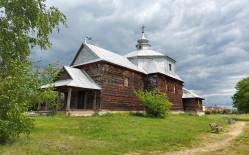
Recommended venues on the Trail
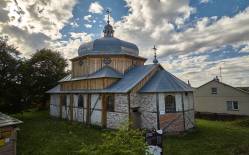
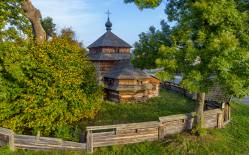
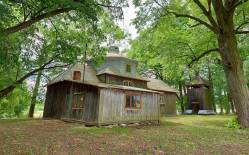
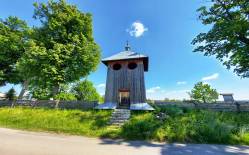



This website has been modernized with the financial support of the European Union under the Cross-Border Cooperation Programme Poland-Belarus-Ukraine 2014-2020. The responsibility for its content lies solely with the Podkarpackie Regional Tourism Board and cannot, in any case, be treated as a reflection of the position of the European Union, the Managing Authority, or the Joint Technical Secretariat of the Cross-Border Cooperation Programme Poland-Belarus-Ukraine 2014-2020.









